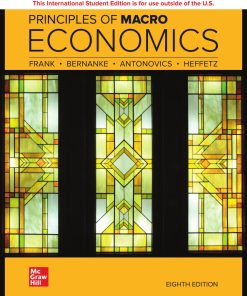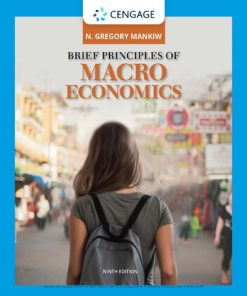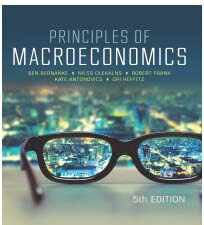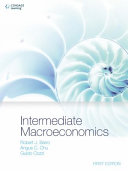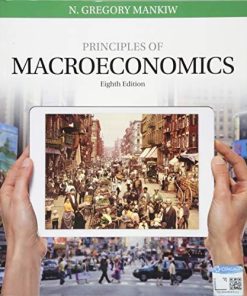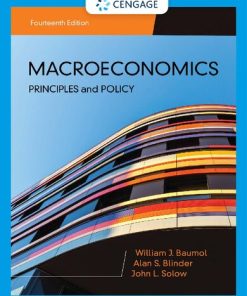(EBook PDF) Macroeconomics Principles and Policy 14th Edition by William Baumol 9798214349077 full chapters
$50.00 Original price was: $50.00.$25.00Current price is: $25.00.
Macroeconomics: Principles and Policy 14th Edition by William J. Baumol – Ebook PDF Instant Download/DeliveryISBN: 9798214349077
Full download Macroeconomics: Principles and Policy 14th Edition after payment
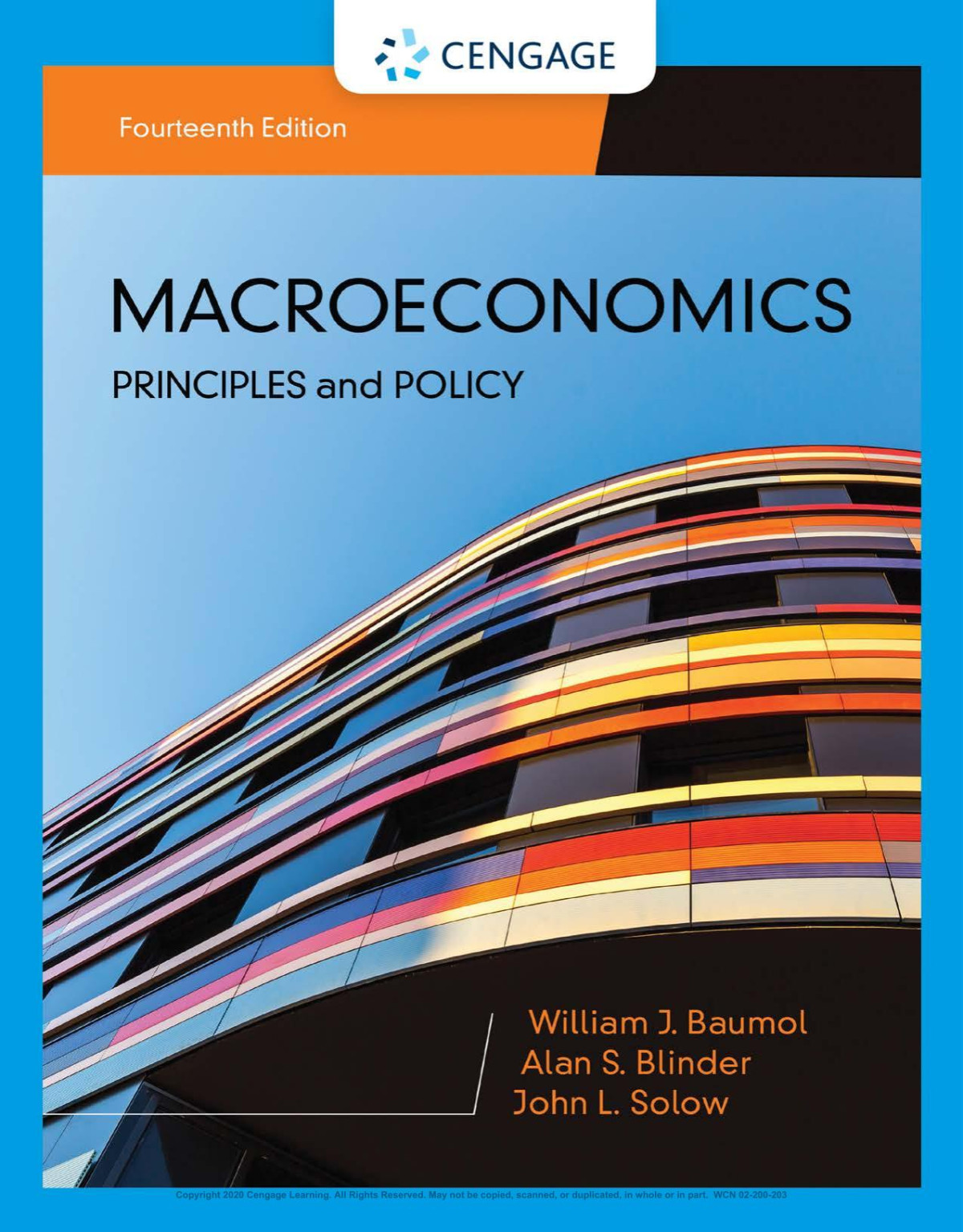
Product details:
ISBN-13 : 9798214349077
Author: William Baumol
Take a strong policy-based approach to teaching introductory microeconomics with Baumol/Blinder/Solow’s leading MICROECONOMICS: PRINCIPLES AND POLICY, 14E. Originally written by two of today’s most respected economists, this new edition adds insights from economic leader and author John Solow. As one of the most up-to-date microeconomics texts available, this edition highlights today’s most recent economic events and policy developments with data as recent as 2018. The authors skillfully connect current events to concepts with an appropriate level of rigor and detail. This edition closes with a new chapter on today’s most important U.S. microeconomic problems and policy debates.
Macroeconomics: Principles and Policy 14th Table of contents:
Part 1. Getting Acquainted with Economics
1. What Is Economics?
1-1. Ideas for Beyond the Final Exam
1-1a. Idea 1: How Much Does It Really Cost?
1-1b. Idea 2: Attempts to Repeal the Laws of Supply and Demand—The Market Strikes Back
1-1c. Idea 3: The Surprising Principle of Comparative Advantage
1-1d. Idea 4: Trade Is a Win–Win Situation
1-1e. Idea 5: The Importance of Thinking at the Margin
1-1f. Idea 6: Externalities—A Shortcoming of the Market Cured by Market Methods
1-1g. Idea 7: The Trade-Off between Efficiency and Equality
1-1h. Epilogue
1-2. Inside the Economist’s Tool Kit
1-2a. Economics as a Discipline
1-2b. The Need for Abstraction
1-2c. The Role of Economic Theory
1-2d. What Is an Economic Model?
1-2e. Reasons for Disagreements: Imperfect Information and Value Judgments
Summary
Key Terms
Discussion Questions
Appendix. Using Graphs: A Review
Summary
Key Terms
Test Yourself
2. The Economy: Myth and Reality
2-1. The American Economy: A Thumbnail Sketch
2-1a. A Private-Enterprise Economy
2-1b. A Relatively “Closed” Economy
2-1c. A Growing Economy …
2-1d. But with Bumps along the Growth Path
2-2. The Inputs: Labor and Capital
2-2a. The American Workforce: Who Is in It?
2-2b. The American Workforce: What Does It Do?
2-2c. The American Workforce: What Does It Earn?
2-2d. Capital and Its Earnings
2-3. The Outputs: What Does America Produce?
2-4. The Central Role of Business Firms
2-5. What’s Missing from the Picture? Government
2-5a. The Government as Referee
2-5b. The Government as Business Regulator
2-5c. Government Expenditures
2-5d. Taxes in America
2-5e. The Government as Redistributor
2-6. Conclusion: It’s a Mixed Economy
Summary
Key Terms
Discussion Questions
3. The Fundamental Economic Problem: Scarcity and Choice
3-1. Scarcity, Choice, and Opportunity Cost
3-1a. Opportunity Cost and Money Cost
3-1b. Optimal Choice: Not Just Any Choice
3-2. Scarcity and Choice for a Single Firm
3-2a. The Production Possibilities Frontier
3-2b. The Principle of Increasing Costs
3-3. Scarcity and Choice for the Entire Society
3-3a. Scarcity and Choice Elsewhere in the Economy
3-4. The Three Coordination Tasks of Any Economy
3-5. The Concept of Efficiency
3-6. Task 1. How the Market Fosters Efficient Resource Allocation
3-6a. The Wonders of the Division of Labor
3-6b. The Amazing Principle of Comparative Advantage
3-6c. The Arithmetic of Comparative Advantage and Trade
3-6d. The Graphics of Comparative Advantage and Trade
3-7. Task 2. Market Exchange and Deciding How Much of Each Good to Produce
3-8. Task 3. How to Distribute the Economy’s Outputs among Consumers
3-9. Looking Ahead
Summary
Key Terms
Test Yourself
Discussion Questions
4. Supply and Demand: An Initial Look
4-1. The Invisible Hand
4-2. Demand and Quantity Demanded
4-2a. The Demand Schedule
4-2b. The Demand Curve
4-2c. Shifts of the Demand Curve
4-3. Supply and Quantity Supplied
4-3a. The Supply Schedule and the Supply Curve
4-3b. Shifts of the Supply Curve
4-4. Supply and Demand Equilibrium
4-4a. The Law of Supply and Demand
4-5. Effects of Demand Shifts on Supply-Demand Equilibrium
4-6. Supply Shifts and Supply-Demand Equilibrium
4-6a. Application: Who Really Pays That Tax?
4-6b. Speculation
4-7. Battling the Invisible Hand: The Market Fights Back
4-7a. Restraining the Market Mechanism: Price Ceilings
4-7b. Case Study: Rent Controls in New York City
4-7c. Restraining the Market Mechanism: Price Floors
4-7d. Case Study: Farm Price Supports and the Case of Sugar Prices
4-7e. A Can of Worms
4-8. A Simple But Powerful Lesson
Summary
Key Terms
Test Yourself
Discussion Questions
Part 2. The Building Blocks of Demand and Supply
5. Consumer Choice: Individual and Market Demand
5-1. Scarcity and Demand
5-2. Utility: A Tool to Analyze Purchase Decisions
5-2a. The Purpose of Utility Analysis: Analyzing How People Behave, Not What They Think
5-2b. Total versus Marginal Utility
5-2c. The “Law” of Diminishing Marginal Utility
5-2d. Using Marginal Utility: The Optimal Purchase Rule
5-2e. From Diminishing Marginal Utility to Downward-Sloping Demand Curves
5-3. Behavioral Economics: Are Economic Decisions Really Made “Rationally”?
5-4. Consumer Choice as a Trade-Off: Opportunity Cost
5-4a. Consumer’s Surplus: The Net Gain from a Purchase
5-5. From Individual Demand Curves to Market Demand Curves
5-5a. Market Demand Curves as a Horizontal Sum of the Demand Curves of Individual Buyers
5-5b. The “Law” of Demand
5-5c. Exceptions to the “Law” of Demand
Summary
Key Terms
Test Yourself
Discussion Questions
Appendix. Analyzing Consumer Choice Graphically: Indifference Curve Analysis
Summary
Key Terms
Test Yourself
6. Demand and Elasticity
6-1. Elasticity: The Measure of Responsiveness
6-1a. Price Elasticity of Demand and the Shapes of Demand Curves
6-2. What Determines Price Elasticities of Demand?
6-3. Price Elasticity of Demand: Its Effect on Total Revenue and Total Expenditure
6-4. Elasticity as a General Concept
6-4a. Income Elasticity
6-4b. Price Elasticity of Supply
6-4c. Cross Elasticity of Demand
6-5. The Time Period of the Demand Curve and Economic Decision Making
6-6. Real-World Application: AOL’s Flat Rate Internet Pricing
6-7. In Conclusion
Summary
Key Terms
Test Yourself
Discussion Questions
Appendix. How Can We Find a True Demand Curve from Historical Statistics?
7. Production, Inputs, and Cost: Building Blocks for Supply Analysis
7-1. The Economic Short Run Versus the Economic Long Run
7-2. Production, Input Choice, and Cost with One Variable Input
7-2a. Total, Average, and Marginal Physical Products
7-2b. Marginal Physical Product and the “Law” of Diminishing Marginal Returns
7-2c. The Optimal Quantity of an Input and Diminishing Returns
7-3. Multiple Input Decisions: The Choice of Optimal Input Combinations
7-3a. Substitutability: The Choice of Input Proportions
7-3b. The Marginal Rule for Optimal Input Proportions
7-3c. Changes in Input Prices and Optimal Input Proportions
7-4. Cost and Its Dependence on Output
7-4a. Fixed Costs and Variable Costs
7-4b. Input Quantities and Total, Average, and Marginal Cost Curves
7-4c. The Law of Diminishing Marginal Productivity and the U-Shaped Average Cost Curve
7-4d. The Average Cost Curve in the Short and Long Run
7-5. Economies of Scale
7-5a. The “Law” of Diminishing Returns and Returns to Scale
7-5b. Historical Costs versus Analytical Cost Curves
7-5c. Cost Minimization in Theory and Practice
Summary
Key Terms
Test Yourself
Discussion Question
Appendix. Production Indifference Curves
Summary
Key Terms
Test Yourself
8. Output, Price, and Profit: The Importance of Marginal Analysis
8-1. Price and Quantity: One Decision, Not Two
8-2. Total Profit: Keep Your Eye on the Goal
8-3. Economic Profit and Optimal Decision Making
8-3a. Total, Average, and Marginal Revenue
8-3b. Total, Average, and Marginal Cost
8-3c. Maximization of Total Profit
8-3d. Profit Maximization: A Graphical Interpretation
8-4. Marginal Analysis and Maximization of Total Profit
8-4a. Marginal Revenue and Marginal Cost: Guides to Optimization
8-4b. Finding the Optimal Price from Optimal Output
8-4c. Producer’s Surplus: The Net Gain from a Sale
8-5. Generalization: The Logic of Marginal Analysis and Maximization
8-5a. Application: Fixed Cost and the Profit-Maximizing Price
8-6. Conclusion: The Fundamental Role of Marginal Analysis
8-7. The Theory and Reality: A Word of Caution
Summary
Key Terms
Test Yourself
Discussion Question
Appendix. The Relationships among Total, Average, and Marginal Data
9. The Financial Markets and the Economy: The Tail that Wags the Dog?
9-1. Corporations and Their Unique Characteristics
9-1a. Financing Corporate Activity: Stocks and Bonds
9-1b. Plowback, or Retained Earnings
9-1c. What Determines Stock Prices? The Role of Expected Company Earnings
9-2. Stock Exchanges and Their Functions
9-2a. Regulation of the Stock Market
9-2b. Stock Exchanges and Corporate Capital Needs
9-3. Betting on Securities: Risks to the Entire Economy
9-3a. Investments and Their Risks
9-3b. Derivatives and Other Complex Security Investments: An Invitation to Gamble?
9-3c. Leverage: Raising the Stakes
9-3d. Herd Behavior, the Securities Markets, and the Path to Recession
9-3e. Irresponsible Lending: Another Booby Trap
Summary
Key Terms
Test Yourself
Discussion Questions
Appendix. Buying Stocks and Bonds
Part 3. The Virtues of the Free Market
10. The Firm and the Industry Under Perfect Competition
10-1. Perfect Competition Defined
10-2. The Perfectly Competitive Firm
10-2a. The Firm’s Demand Curve under Perfect Competition
10-2b. Short-Run Equilibrium for the Perfectly Competitive Firm
10-2c. Short-Run Profit: Graphic Representation
10-2d. The Case of Short-Term Losses
10-2e. Shutdown Analysis
10-2f. The Perfectly Competitive Firm’s Short-Run Supply Curve
10-3. The Perfectly Competitive Industry
10-3a. The Perfectly Competitive Industry’s Short-Run Supply Curve
10-3b. Industry Equilibrium in the Short Run
10-3c. Industry and Firm Equilibrium in the Long Run
10-3d. Zero Economic Profit: The Opportunity Cost of Capital
10-3e. The Long-Run Industry Supply Curve
10-4. Perfect Competition and Productive Efficiency
Summary
Key Terms
Test Yourself
Discussion Questions
11. The Case for Free Markets: The Price System
11-1. Efficient Resource Allocation and Pricing
11-2. Scarcity and the Need to Coordinate Economic Decisions
11-2a. Three Coordination Tasks in the Economy
11-2b. The Near Impossibility of Central Planning
11-2c. Which Buyers and Which Sellers Get Priority?
11-3. How Perfect Competition Achieves Efficiency: A Graphic Analysis
11-4. How Perfect Competition Achieves Efficient Output: Marginal Analysis
Step 1: Rule for Efficient Output Selection
11-4a. The Invisible Hand at Work
11-4b. Other Roles of Prices: Income Distribution and Fairness
11-4c. Can Price Increases Ever Serve the Public Interest?
11-4d. Yet Another Free-Market Achievement: Growth versus Efficiency
11-5. Toward Assessment of the Price Mechanism
Summary
Key Terms
Test Yourself
Discussion Questions
Part 4. The Limitations of Free Markets
12. Monopoly
12-1. Monopoly Defined
12-1a. Sources of Monopoly: Barriers to Entry and Cost Advantages
12-1b. Natural Monopoly
12-2. The Monopolist’s Supply Decision
12-2a. Determining the Monopolist’s Profit-Maximizing Output and Price
12-2b. Comparing Monopoly and Perfect Competition
12-2c. Monopoly May Shift Demand or Cost Curves
12-3. Can Anything Good be Said about Monopoly?
12-3a. Monopoly May Aid Innovation
12-3b. Natural Monopoly: Where Single-Firm Production Is Cheapest
12-4. Price Discrimination Under Monopoly
12-4a. Is Price Discrimination Always Undesirable?
12-5. Monopsony: The Case of a Single Buyer
Summary
Key Terms
Test Yourself
Discussion Questions
13. Between Competition and Monopoly
13-1. Monopolistic Competition
13-1a. Characteristics of Monopolistic Competition
13-1b. Price and Output Determination under Monopolistic Competition
13-1c. The Excess Capacity Theorem and Resource Allocation
13-2. Oligopoly
13-2a. Why Oligopolistic Behavior Is So Difficult to Analyze
13-2b. A Shopping List
13-3. The Game Theory Approach
13-3a. Games with Dominant Strategies
13-3b. Games without Dominant Strategies
13-3c. The Nash Equilibrium
13-3d. Threats and Credibility
13-3e. Zero-Sum Games
13-3f. Repeated Games
13-4. Contestable Markets
13-5. A Glance Backward: Comparing the Four Market Structures
13-6. Monopolistic Competition, Oligopoly, and Public Welfare
Summary
Key Terms
Test Yourself
Discussion Questions
14. Limiting Market Power: Antitrust and Regulation
14-1. The Public Interest Issue: Monopoly Power Versus Mere Size
14-2. Antitrust Laws and Policies
14-3. Anticompetitive Behavior and Antitrust
14-3a. Collusion
14-3b. Dominant Firms and Market Definition
14-3c. Anticompetitive Acts
14-4. Concentration
14-4a. Measuring Concentration
14-4b. The Evidence of Concentration in Reality
14-5. What Is Price Regulation?
14-6. The Logic behind Price Regulation
14-6a. Economies of Scale and Scope
14-6b. Universal Service and Rate Averaging
14-7. Difficulties with Price Regulation
14-8. The Deregulation Experience
Effects on Local Services 1.
Summary
Key Terms
Discussion Questions
15. The Shortcomings of Free Markets
15-1. What Does the Market Do Poorly?
15-2. Efficient Resource Allocation: A Review
15-3. Externalities: Getting the Prices Wrong
15-3a. Externalities and Inefficiency
15-3b. Externalities Are Everywhere
15-3c. Government Policy and Externalities
15-4. Provision of Public Goods
15-5. Allocation of Resources between Present and Future
15-5a. The Role of the Interest Rate
15-5b. How Does It Work in Practice?
15-6. Imperfect Information
15-6a. Information as a Good
15-6b. Asymmetric Information and the “Lemons” Problem
15-6c. Adverse Selection and Moral Hazard
15-6d. Principals and Agents
15-7. Market Failure and Government Failure
15-8. The Cost Disease of Personal Services
15-8a. Deteriorating Personal Services
15-8b. Personal Services Are Getting More Expensive
15-8c. Why Are These “In-Person” Services Costing So Much More?
15-8d. Uneven Labor Productivity Growth in the Economy
15-8e. Is a Future of More Goods but Fewer Services Inevitable?
15-8f. Solving the Problem May Make the Problem Worse
15-9. The Market System on Balance
15-10. Epilogue: The Unforgiving Market, Its Gift of Abundance, and Its Dangerous Friends
Summary
Key Terms
Test Yourself
Discussion Questions
16. Externalities, The Environment, and Natural Resources
16-1. The Economics of Environmental Protection
16-2. Review—Externalities: A Critical Shortcoming of the Market Mechanism
16-2a. The Facts: Is the World Really Getting Steadily More Polluted?
16-2b. The Role of Individuals and Governments in Environmental Damage
16-2c. Pollution and the Law of Conservation of Matter and Energy
16-3. Basic Approaches to Environmental Policy
Voluntarism 1.
16-3a. Emissions Taxes versus Direct Controls
Enforcement Issues
16-3b. Another Financial Device to Protect the Environment: Cap-and-Trade
16-4. Two Cheers for the Market
16-5. The Economics of Natural Resources
16-6. The Free Market and Pricing of Natural Resources
16-7. Exhaustible Resources, Scarcity, and Rising Prices
16-7a. Supply-Demand Analysis and Consumption
16-7b. Actual Exhaustible Resource Prices in the Twentieth Century
16-7c. Other Factors Affecting Natural Resource Price Patterns
16-7d. Are Rising Resource Prices a Problem?
16-8. The Bioeconomics of Renewable Resources
16-8a. The Problem of Common Property Resources
16-8b. Solving the Common Property Resource Problem
Summary
Key Terms
Test Yourself
Discussion Questions
17. Taxation and Resource Allocation
17-1. Basic Tax Concepts
17-1a. Tax Base and Tax Rates
17-1b. Progressive, Proportional, and Regressive Taxes
17-1c. Direct versus Indirect Taxes
17-1d. The Level of Taxes in the United States
17-2. The Federal Tax System
17-2a. The Federal Personal Income Tax
17-2b. The Payroll Tax
17-2c. The Corporate Income Tax
17-2d. Excise Taxes
17-2e. The Payroll Tax and the Social Security System
17-3. The State and Local Tax System
17-3a. Sales and Excise Taxes
17-3b. Property Taxes
17-3c. Fiscal Federalism
17-4. The Concept of Equity in Taxation
17-4a. Horizontal Equity
17-4b. Vertical Equity
17-4c. The Benefits Principle
17-5. The Concept of Efficiency in Taxation
17-5a. Tax Loopholes and Excess Burden
17-6. Shifting the Tax Burden: Tax Incidence
17-6a. The Incidence of Excise Taxes
17-6b. Example: The Incidence of the Payroll Tax
17-7. When Taxation Can Improve Efficiency
17-8. Equity, Efficiency, and the Optimal Tax
Summary
Key Terms
Test Yourself
Discussion Questions
Appendix: A Graphical Analysis of Excess Burden
Part 5. The Distribution of Income
18. Pricing the Factors of Production
18-1. The Principle of Marginal Productivity
18-2. Inputs and Their Derived Demand Curves
18-3. Investment, Capital, and Interest
18-3a. The Demand for Funds
18-3b. The Downward-Sloping Demand Curve for Funds
18-3c. The Supply of Funds and the Equilibrium Interest Rate
18-3d. The Issue of Usury Laws: Are Interest Rates Too High?
18-4. The Determination of Rent
18-4a. Land Rents: Further Analysis
18-4b. Generalization: Economic Rent Seeking
18-4c. Rent as a Component of an Input’s Compensation
18-4d. An Application of Rent Theory: Salaries of Professional Athletes
18-5. Payments to Business Owners: Are Profits Too High or Too Low?
18-5a. What Accounts for Profits?
18-5b. Taxing Profits
18-6. Criticisms of Marginal Productivity Theory
Summary
Key Terms
Test Yourself
Discussion Questions
Appendix. Discounting and Present Value
Summary
Key Term
Test Yourself
19. Labor and Entrepreneurship: The Human Inputs
19-1. The Markets for Labor
19-2. Wage Determination in Competitive Markets
19-2a. The Demand for Labor and the Determination of Wages
19-2b. Influences on MRP L : Shifts in the Demand for Labor
19-2c. Technical Change, Productivity Growth, and the Demand for Labor
19-2d. The Service Economy and the Demand for Labor
19-3. The Supply of Labor
19-3a. Changes in Labor-Force Participation
19-3b. An Important Labor Supply Conundrum
19-3c. The Labor Supply Conundrum Resolved
19-4. Why Do Wages Differ?
19-4a. Labor Demand in General
19-4b. Labor Supply in General
19-4c. Investment in Human Capital
19-4d. Teenagers: A Disadvantaged Group in the Labor Market
19-5. Unions And Collective Bargaining
19-5a. Unions as Labor Monopolies
19-5b. Monopsony and Bilateral Monopoly
19-5c. Collective Bargaining and Strikes
19-6. The Entrepreneur: The Other Human Input
19-7. The Market Economy’s Incredible Growth Record
19-8. Sources of Free-Market Innovation: The Role of the Entrepreneur
19-8a. Breakthrough Invention and the Entrepreneurial Firm
19-9. Entrepreneurship and Growth
19-9a. The Entrepreneur’s Prices and Profits
19-9b. Fixed Costs and Public Good Attributes in Invention and Entrepreneurship
19-9c. Discriminatory Pricing of an Innovative Product over Its Life Cycle
19-9d. Negative Financial Rewards for Entrepreneurial Activity?
19-10. Institutions and the Supply of Innovative Entrepreneurship
Summary
Key Terms
Test Yourself
Discussion Questions
20. Poverty, Inequality, and Discrimination
20-1. The Facts: Poverty
20-1a. Counting the Poor: The Poverty Line
20-1b. Absolute versus Relative Poverty
20-2. The Facts: Inequality
20-3. Some Reasons for Unequal Incomes
Differences in Ability
20-4. The Facts: Discrimination
20-5. The Trade-Off Between Equality and Efficiency
20-6. Policies to Combat Poverty
20-6a. Education as a Way Out
20-6b. The Welfare Debate and the Trade-Off
20-6c. The Negative Income Tax
20-7. Other Policies to Combat Inequality
20-7a. The Personal Income Tax
20-7b. Death Duties and Other Taxes
20-8. Policies to Combat Discrimination
20-9. A Look Back
Summary
Key Terms
Test Yourself
Discussion Questions
Appendix. The Economic Theory of Discrimination
Summary
Key Term
Part 6. The United States in the World Economy
21. International Trade and Comparative Advantage
21-1. Why Trade?
21-1a. Mutual Gains from Trade
21-2. International Versus Intranational Trade
21-2a. Political Factors in International Trade
21-2b. The Many Currencies Involved in International Trade
21-2c. Impediments to Mobility of Labor and Capital
21-3. The Principle of Comparative Advantage
21-4. The Arithmetic of Comparative Advantage
21-4a. The Graphics of Comparative Advantage
21-4b. Must Specialization Be Complete?
21-5. Tariffs, Quotas, and Other Interferences with Trade
21-5a. Tariffs versus Quotas
21-6. Why Inhibit Trade?
21-6a. Gaining a Price Advantage for Domestic Firms
21-6b. Protecting Particular Industries
21-6c. National Defense and Other Noneconomic Considerations
21-6d. The Infant-Industry Argument
21-6e. Strategic Trade Policy
21-7. Can Cheap Imports Hurt a Country?
Summary
Key Terms
Test Yourself
Discussion Questions
Appendix. Supply, Demand, and Pricing in World Trade
Summary
Test Yourself
Part 7. The Economy Today
22. Contemporary Issues in the U.S. Economy
22-1. Will Artificial Intelligence Leave No Work for Humans to Do?
22-2. Are Uber and Airbnb the Markets of the Future?
22-3. Is the “Gig” Economy the Future of Work?
22-4. Is the Student Debt “Crisis” Really a Crisis?
22-5. How Will We Pay for Health Insurance?
People also search for Macroeconomics: Principles and Policy 14th:
macroeconomics principles and policy 14th edition pdf
macroeconomics principles and policy 13th edition
macroeconomics principles and policy 13th edition pdf
macroeconomics principles and policy 14th edition
macroeconomics principles and policy 12th edition pdf
Tags:
Macroeconomics,Principles,William Baumol,economists
You may also like…
Business & Economics - Economics
Business & Economics
Brief principles of macroeconomics Ninth Edition N. Gregory Mankiw
Business & Economics
Business & Economics - Mathematical Economics
Uncategorized
Computers - Security
Business & Economics





